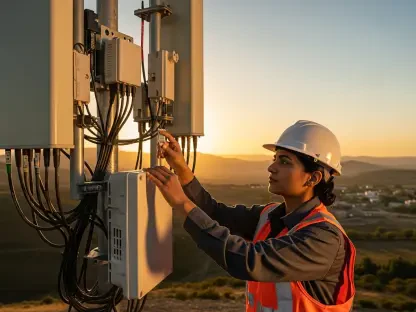In the heart of rural Vermont, a groundbreaking $180 million proposal by the Vermont Community Broadband Board is stirring hope for a long-overdue transformation in internet connectivity, especially in the Northeast Kingdom (NEK), a region where digital access has remained elusive for far too many. This ambitious plan, fueled primarily by federal funds from the Broadband Equity, Access, and Deployment (BEAD) program, seeks to extend reliable broadband to 99% of households across the state, a staggering goal for an area defined by rugged mountains and sparse populations. The NEK, home to over half of Vermont’s underserved residents, stands as the focal point of this initiative, with local leaders heralding it as a rare opportunity to erase digital disparities. Beyond mere infrastructure, this effort promises to reshape daily life, from enabling remote work to improving access to critical services like healthcare. Yet, as the plan unfolds, significant challenges loom on the horizon, raising questions about whether this substantial investment can truly close the gap in one of America’s most rural corners.
A Lifeline for the Northeast Kingdom
The Northeast Kingdom, a sprawling region of 72 towns, is poised to become the primary beneficiary of this broadband expansion, with NEK Broadband securing over $93 million of the total funding. This substantial allocation will facilitate the construction of more than 1,000 miles of fiber-optic infrastructure, connecting nearly 10,000 addresses that have long been cut off from consistent internet. For many residents, this could mark a turning point, breaking down barriers to online education, remote job opportunities, and telemedicine services that urban areas often take for granted. The scale of this project underscores a deep commitment to addressing the isolation that has plagued the region, positioning connectivity as a fundamental tool for economic and personal growth. If successful, the impact could ripple through generations, fundamentally altering how communities in this remote area engage with the modern world.
Beyond the technical upgrades, the social and cultural implications for the NEK are profound. Christa Shute, a key figure at NEK Broadband, emphasizes that internet access is not just about practicality but about strengthening community bonds, allowing residents to maintain relationships and participate in civic activities from the comfort of their homes. Additionally, targeted programs offering reduced rates and free installation for low-income households ensure that the benefits of this initiative reach those most in need. This focus on equity aims to prevent the digital divide from widening further, making sure that financial constraints do not exclude anyone from the advantages of connectivity. By prioritizing inclusivity alongside infrastructure, the plan seeks to create a more cohesive and empowered regional identity, where access to technology becomes a shared right rather than a distant luxury.
Prioritizing Fiber in a Rugged Landscape
At the core of this broadband strategy lies a deliberate choice to invest in fiber-optic technology, which will cover 90% of the nearly 15,000 locations funded through the BEAD program. State officials, including Christine Hallquist of the Vermont Community Broadband Board, argue that fiber provides unmatched reliability and speed, a necessity in Vermont’s challenging terrain of steep mountains and thick forests where other solutions often fail. Unlike alternatives, fiber can withstand the environmental hurdles that frequently disrupt service in such areas, ensuring consistent access for rural users. This decision to prioritize fiber over less dependable options reflects a long-term vision for connectivity that aims to meet the needs of residents not just today but well into the future, establishing a robust foundation for digital growth across the state.
In contrast, satellite-based solutions, such as those offered by SpaceX’s Starlink, have been largely sidelined, designated for less than 7% of locations where fiber installation costs exceed $17,000 per site. While satellite technology might appear cost-effective at first glance, its performance often falters in Vermont’s unique geography, where dense foliage and elevation changes interfere with signal quality. The strategic focus on fiber underscores a commitment to quality over short-term savings, recognizing that sustainable infrastructure is critical for rural communities to thrive in an increasingly digital world. By betting on fiber, the state is not merely addressing current gaps but also future-proofing its network against the evolving demands of technology, a move that could set a precedent for other rural regions facing similar connectivity challenges.
Navigating Federal and Bureaucratic Hurdles
Implementing a project of this magnitude is no small feat, especially with bureaucratic obstacles complicating the path forward. Recent rule changes by the National Telecommunications and Information Administration (NTIA) under the Trump administration have introduced unexpected challenges, including a stringent 90-day deadline for revised state proposals and a push to consider satellite internet as a comparable alternative to fiber. These shifts, combined with a federal emphasis on cost reduction and the relaxation of certain regulatory standards, have created a complex landscape for Vermont’s broadband planners. Such changes threaten to disrupt the carefully crafted balance between affordability and quality, forcing state officials to adapt quickly while maintaining their commitment to equitable and sustainable solutions.
Despite these hurdles, optimism persists within the Vermont Community Broadband Board, which remains confident in securing federal approval for the proposal. Some providers have even begun preliminary work at their own financial risk, a testament to the urgency and belief in the project’s potential. However, uncertainties surrounding the allocation of remaining BEAD funds and the tight submission timeline continue to cast a shadow over the process. Local leaders have responded by renegotiating agreements with providers to lower costs without compromising on critical standards like environmental responsibility and fair labor practices, which are safeguarded by state laws. The ability to navigate these federal complexities will ultimately determine whether the initiative can maintain its momentum or risk stalling under administrative weight, a concern that keeps stakeholders on edge as deadlines approach.
Voices of Hope and Broader Community Impact
Across Vermont, a chorus of stakeholders expresses a blend of cautious optimism and determination regarding the broadband plan. Ellie de Villiers of the Vermont Communications Union District Association applauds the decision to allocate significant funding to local districts rather than large for-profit corporations, viewing it as a victory for community-driven solutions and terrestrial technology. Meanwhile, private entities like Comcast have committed to enhancing consumer choice and service reliability through partnerships with local districts, signaling a collaborative spirit. These varied perspectives highlight a unified goal: ensuring that rural Vermonters gain access to the digital tools necessary for modern life, a mission that transcends organizational boundaries and focuses on tangible outcomes for residents.
In the NEK specifically, the emphasis on affordability and inclusivity strikes a powerful chord, as noted by Heather Alger of Northeast Kingdom Community Action. The potential to transform lives through affordable internet access for low-income families is seen as nothing short of revolutionary, addressing not just economic disparities but also social isolation. This initiative goes beyond mere connectivity; it’s about fostering resilient communities where every individual has the opportunity to engage with the broader world. By weaving together economic benefits with cultural and personal growth, the plan aims to redefine what it means to live in a rural area, proving that technology can be a great equalizer when paired with a commitment to fairness and accessibility.
Reflecting on a Transformative Opportunity
Looking back, the rollout of Vermont’s $180 million broadband proposal stood as a defining moment in the state’s journey toward digital equity, particularly for the Northeast Kingdom. The substantial investment, with over $93 million directed to NEK Broadband, represented a historic push to connect thousands of isolated households through reliable fiber-optic infrastructure. Despite facing bureaucratic challenges and federal policy shifts, the resilience shown by local leaders and the Vermont Community Broadband Board in adapting to tight deadlines and cost pressures was commendable. Their focus on sustainable technology and inclusivity set a high standard for rural broadband initiatives nationwide. Moving forward, the next steps should involve close monitoring of federal approvals and fund allocations to ensure momentum is not lost. Additionally, continued collaboration between local districts and private partners will be crucial to sustain progress, while expanding affordability programs could further solidify the commitment to leaving no one behind in this digital revolution.









